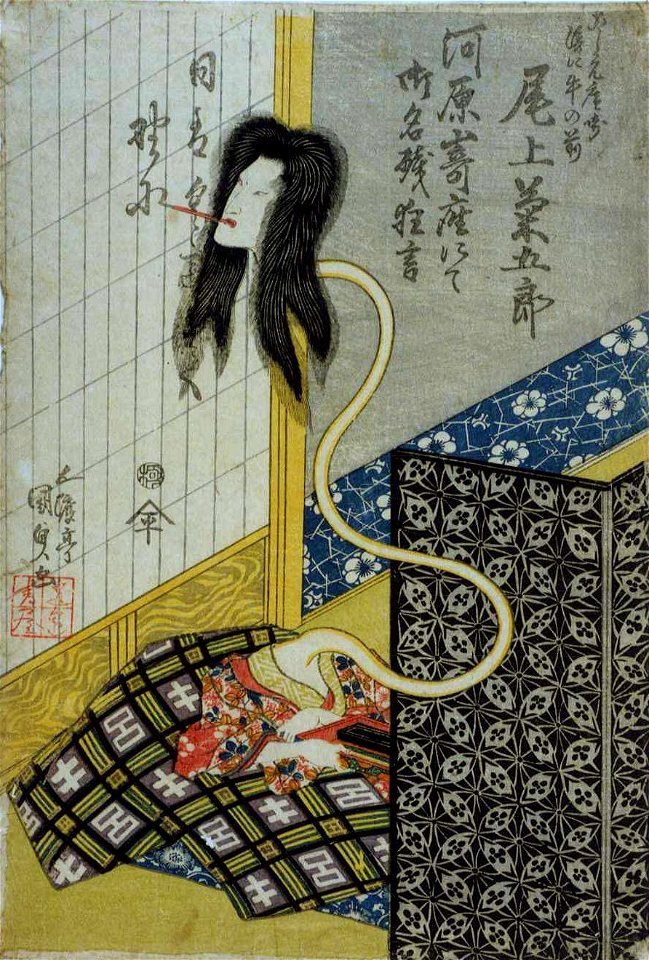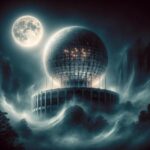Introduction to Rokurokubi
The Rokurokubi are a captivating part of Japanese folklore, presenting a rich tapestry of supernatural and human elements. These beings, primarily depicted as women, are distinguished by their extraordinary ability to stretch their necks to great lengths.
The term ‘Rokurokubi’ originates from the Japanese language and translates literally to ‘pulley necks’. The ‘roku’ part refers to a ‘wheel’ or ‘pulley’, while ‘kubi’ means ‘neck’. This nomenclature perfectly encapsulates the unusual feature of these mythical beings — their elongated, flexible necks that can stretch and retract, adding a unique, eerie charm to the legend.
Origins of the Rokurokubi Legends
The Rokurokubi legends find their roots in Japan during the Edo period, a time rich in folklore and supernatural tales. These stories often served to explain unusual phenomena, entertain, or impart moral lessons. They emerged as a fascinating figure within this milieu of imaginative storytelling.

Early descriptions of Rokurokubi depict them as women who, during the night, experience a bizarre transformation. Their necks stretch to incredible lengths, allowing their heads to move independently from their bodies. By day, these women live as normal human beings, indistinguishable from others. The condition is said to be either a curse, a disease, or a manifestation of spiritual energy or “kami” within the person. This physical deformity remains hidden during the day and reveals itself only at night when the Rokurokubi loses control over her body.
The Tale of Rokurokubi
Rokurokubi are often subjects of captivating tales that underline their unusual nature and the shock of unsuspecting individuals who encounter them. The legends mostly revolve around these women leading normal lives during the day, while their secret reveals itself only under the cover of night.
The appearance of a Rokurokubi in her supernatural form is an uncanny sight. While her body remains stationary, her neck elongates, allowing her head to roam freely, floating in the air. Her face retains its human features, but the sight of a disembodied head creates a visage that is both intriguing and frightening.
As for their behavior, Rokurokubi are generally not depicted as malicious or dangerous. However, the shock and fear they inspire often cause turmoil or chaos. They are also known to startle or play pranks on humans, either for amusement or to feed off their life energy.
Interestingly, their supernatural abilities seem to be limited to their extraordinary neck stretching. Some versions of the legend suggest that Rokurokubi can control this transformation, while others imply that it happens without their knowledge or consent, often when they’re asleep. It is also said that seeing one in her extended form could make her powerless or even lead to her death.
Rokurokubi in Literature and Art
Rokurokubi have been a staple of Japanese culture for centuries, particularly within literature, Ukiyo-e art, and Kabuki theater. They emerged during the Edo period, a time known for its burgeoning urban culture and growing appetite for tales of the supernatural.
In literature, Rokurokubi feature prominently in Kaidan, or ghost stories. These narratives usually paint Rokurokubi as tragic figures, often women who have been cursed or transformed due to a spiritual transgression or unfulfilled obligation. The tales of Lafcadio Hearn, a notable Greek-born writer known for his collections of Japanese legends and ghost stories, include a few poignant portrayals of Rokurokubi.

The visual arts, particularly Ukiyo-e, also helped popularize the legend. Ukiyo-e, translated as ‘pictures of the floating world’, is a genre of Japanese art that flourished from the 17th to the 19th century. Rokurokubi, with their elongated, serpentine necks, were often subjects of Ukiyo-e prints, contributing to their spread and recognition.
Kabuki theater, a classical Japanese dance-drama known for its stylized performances and elaborate costumes, occasionally incorporated Rokurokubi in its plays. These theatrical performances gave audiences a vivid, visual experience of the legends, further embedding the creatures in Japan’s cultural consciousness.
In contemporary Japanese culture, Rokurokubi continue to make appearances in manga, anime, and film, introducing them to new generations and ensuring their enduring presence in the landscape of Japanese folklore.
Variations of the Rokurokubi Legend
While the core legend of the Rokurokubi – a woman whose neck stretches to incredible lengths – remains consistent, there are variations across different regions of Japan and in comparison with other cultures.
The classic depiction of a Rokurokubi is that of a seemingly normal woman who, during the night, can elongate her neck to spy on or startle individuals. However, there are also tales of Rokurokubi being capable of detaching their heads completely, which then roam around independently, known as ‘Nukekubi’. Some versions also ascribe Rokurokubi the ability to change their appearance, usually to that of a loved one, to deceive their victims.
These variations often reflect the diverse cultural influences and regional histories in Japan. Some communities tell tales of more benign Rokurokubi who lead ordinary lives during the day, while others emphasize their frightening nocturnal escapades.
Interestingly, the Rokurokubi legend has parallels with similar mythical creatures in other cultures. The concept of a creature that can extend or detach parts of its body is prevalent in various folklore traditions around the world. For example, the Penanggalan in Malaysian folklore is a woman capable of detaching her head, which flies around seeking blood. Similarly, the Naga, serpentine creatures from Hindu and Buddhist mythology, also have the ability to shape-shift and extend their bodies. These similarities provide a fascinating glimpse into how different cultures interpret and reimagine similar supernatural concepts.
Modern Interpretations and Media Influence
Rokurokubi, like many figures from traditional Japanese folklore, have found their place in modern media, which has given them an entirely new life in the public consciousness. Manga, anime, and films have incorporated the image of the spirit in their narratives, often reinventing their traditional image to fit contemporary settings and themes.
Manga series like ‘GeGeGe no Kitaro‘ and ‘Hell Teacher Nūbē‘ have featured Rokurokubi as characters, usually showcasing their supernatural ability to stretch their necks as both a source of humor and horror. Anime series such as ‘Mononokean‘ and ‘Ayakashi: Samurai Horror Tales‘ also depict Rokurokubi, further promoting their image to a global audience.
Modern Japanese horror films have likewise used the figures as a symbol of horror, their long necks often used to create visually impactful and chilling scenes. A notable example is the film ‘Kwaidan‘, which portrays a Rokurokubi as a vengeful spirit.

Contemporary interpretations often take liberties with the traditional image of the Rokurokubi. Some modern depictions emphasize their monstrous nature more than the older tales, presenting them as malevolent spirits rather than simply mischievous. Others may integrate them into modern urban settings, framing them as city-dwelling entities rather than beings tied to traditional rural landscapes.
These modern depictions have not only revitalized interest in them but also reshaped their image, showing how folklore continues to evolve and adapt in response to cultural shifts and new media landscapes.
Conclusion
The Rokurokubi have left a profound mark on Japanese folklore, their unique and unsettling image capturing imaginations for centuries. Initially, they served as cautionary figures in morality tales, often used to convey lessons about indulgence, deceit, or the dangers of straying from societal norms.
Despite their unsettling appearance, the stories of Rokurokubi often evoke a sense of sympathy. The women who become these creatures are often innocent victims of unfortunate circumstances or deceitful men, reflecting societal anxieties about the role and treatment of women.
However, Rokurokubi are more than mere symbols of bygone societal fears and values. Their enduring presence in modern Japanese media – from manga and anime to film – attests to their continued relevance and appeal. Whether they’re serving as comedic relief or chilling horror elements, they continue to engage audiences with their distinct blend of the familiar and the supernatural.
In a broader context, the enduring fascination with the Rokurokubi speaks to a universal human interest in the strange, the mysterious, and the uncanny. Whether in the ancient folk tales of Japan or the bustling modern landscape of global pop culture, the Rokurokubi stand as compelling reminders of the power and persistence of folklore in shaping our shared imaginative landscapes.






